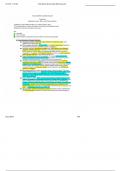Exam (elaborations)
Advanced Med Surg (Med Surg III) Final Exam Respiratory , Neuro, Burns, and Previous Exams
- Course
- Institution
Advanced Med Surg (Med Surg III) Final Exam Respiratory , Neuro, Burns, and Previous Exams Key: III = Important. III = V ery Important. III = Direct answers to questions from the professor ’s previous study guides. 1. Acute Respiratory Distress Syndrome ● T reatment for ARDS: I ...
[Show more]



